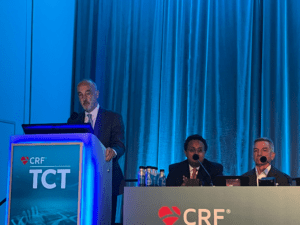Patient-level dataset on paclitaxel and death that helped sway the ... - Vascular News

Data from a patient-level meta-analysis—a factor in the US Food and Drug Administration's (FDA) recent change of position on the use of paclitaxel-coated devices to treat peripheral arterial disease (PAD)—have been made public for the first time at TCT 2023 (23–26 October, San Francisco, USA).
The analysis led investigators to conclude that there is no association between mortality risk and paclitaxel-coated device exposure or dose, and should provide reassurance to patients, physicians and regulators on the safety of paclitaxel-coated devices, they say.
The release of the data, which has also been published today in The Lancet, draws a line in the sand over the question of the safety of paclitaxel, which is used in peripheral interventions to prevent restenosis, after data from a summary-level meta-analysis put forward in 2018 pointed to an increased risk of death at two and five years following the use of paclitaxel-coated devices in the femoropopliteal artery.
William A Gray (Lankenau Heart Institute, Wynnewood, USA) told TCT attendees that the analysis provides the most complete and current follow-up data of pivotal studies associated with FDA-approved paclitaxel-coated devices and represents the most complete patient-level analysis to date, or likely to be available in the future.
Gray presented the findings on behalf of an independent physician steering committee, comprising Sahil Parikh (Columbia University Irving Medical Center, New York, USA), Peter Schneider (University of California San Francisco, San Francisco, USA), Christopher Mullin and Tyson Rogers (both North American Science Associates [NAMSA], Minneapolis, USA), who were enlisted by the regulator and industry to dig into the final and updated patient-level datasets and address limitations of prior paclitaxel meta-analyses. Funding for the study came from BD, Boston Scientific, Cook, Medtronic, Philips, Surmodics and TriReme Medical, though the funders of the study had no role in its design, data analysis, data interpretation, or writing of the report, but did provide patient-level data for the analysis, which was independently conducted.
The use of paclitaxel-coated devices for the treatment of PAD dropped by as much as 50% due to changes in practice patterns worldwide, Gray said, which was in response to the FDA's 2019 statement that use of paclitaxel-coated balloons and paclitaxel-eluting stents was "potentially associated with increased mortality". This change in position came after a meta-analysis from Konstantinos Katsanos (University of Patras, Patras, Greece) et al had first raised the spectre of a mortality risk. FDA removed the red flag in July this year, stating that "additional data from the pivotal randomised controlled trials (RCTs) ha[ve] become available" in a letter to healthcare providers in which it set out the decision.

To inform this decision, Gray and his co-investigators analysed randomised trials that evaluated FDA-approved paclitaxel-coated devices versus uncoated devices for the treatment of femoropopliteal artery disease, looking primarily at the mortality risk on an intention-to-treat basis, with key secondary analyses including dose/mortality and covariate interactions.
Data from 10 trials were included, encompassing 2,666 participants over a median follow-up of 4.9 years. One-year follow-up was available in 98.7% of evaluable participants and five-year follow-up in 95%, which Gray noted represents an additional 3,355.5 patient years since a 2020 analysis by VIVA Physicians, in which investigators identified an absolute 4.6% increased mortality risk associated with paclitaxel-coated devices, albeit demonstrating a weaker mortality signal than was initially reported in December 2018 by Katsanos et al.
Results of the latest analysis presented by Gray and published in The Lancet demonstrated an overall hazard ratio (HR) for the intention to treat populationof 1.14 (95% confidence interval [CI] 0.93–1.40). In post-hoc analyses assessing the proportional hazards assumption, there was no evidence the assumption was violated. HRs for individual studies ranged from 0.32 to 1.52, and there were no studies in which the CI did not include the null value of 1. The HR for the as-treated analysis was 1.13 (0.92–1.39). Furthermore, the as-treated crossover analyses also did not show a significant difference in deaths between the paclitaxel-coated and control groups, with an HR of 1.07 (0.87–1.31) when late crossovers were censored, and 1.04 (0.84–1.28) in the time-varying analysis of late crossovers. Examination of late crossover using iterative parameter estimations also failed to detect a significant effect on deaths.
In their report of the findings in The Lancet, investigators describe their dataset as "very likely to be the most complete and thoroughly vetted dataset to emerge regarding paclitaxel-coated devices and death, given the likelihood that randomised trials against control devices will no longer have clinical equipoise for effectiveness, and the substantial coordination efforts for data collection, analysis and multilateral consensus will be difficult to recapitulate".
They also praise the collaborative and thorough efforts of many clinicians, industry sponsors, and regulators over several years that enabled this research.
"The most important takeaways are that: number one, we [have] learned a tremendous amount about how future studies should be planned, so that we do not go down a blind alley again to be fooled by a summary level meta-analysis," Schneider tells this newspaper, reflecting on the takeaways from the research.
"The second thing is that this was a tremendous effort to resolve this problem, and that included collaboration like we have never had before between physicians of different specialties in different parts of the world, with industry and with regulatory bodies all over the geography, but especially with FDA, [which] has been extremely collaborative and has been all about problem solving since the beginning of this issue."
"Here we have probably the most complete dataset that will be feasible from the randomised controlled trials," comments Parikh. "We looked at the overall percentage of patients identified with vital status at five years, and it was 95% of the total cohort of almost 2,700 patients. I think it will be hard to find a more complete dataset at this level of detail."
More importantly, adds Parikh, was the opportunity to conduct crossovers analyses.
"We are identifying exposure to paclitaxel in any way, to the maximum extent possible, and, with each subsequent iteration of the analysis, our findings showed a closer and closer point estimate to no hazard at all, to unity," he says. "That really emphasises that going the extra mile to identify every exposure to paclitaxel, in this case most often with a contralateral limb intervention or reintervention, was the appropriate approach to adjudicate paclitaxel exposure and its risk."
Comments
Post a Comment